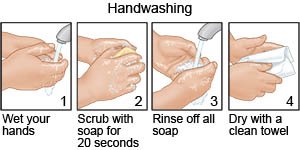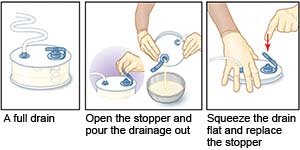Hemovac Drain Care
Medically reviewed by Drugs.com. Last updated on Apr 6, 2025.
What is a Hemovac drain and how does it work?
A Hemovac drain is used to remove fluids that build up in an area of your body after surgery. The Hemovac drain is a circular device connected to a tube. One end of the tube is placed in the surgery site. The other end comes out through a small cut in your skin, called the drain site. The device is connected to this end. You may have 1 or more stitches to hold the tube in place. The Hemovac drain removes fluid by creating suction in the tube. The circular device is squeezed flat and expands as it fills with fluid.
How do I change the bandage around my Hemovac drain?
If you have a bandage, change it 1 time each day. Change your bandage if it gets wet.
- Wash your hands with soap and water.

- Loosen the tape and gently remove the old bandage. Throw the old bandage away.
- Use soap and water or saline (salt water) solution to clean your drain site. Dip a cotton swab or gauze pad in the solution and gently clean your skin. Begin cleaning near the drain site and wipe away from the site. Do not wipe towards the drain site. Use a new swab or pad after each wipe.
- Pat the area dry. Check for signs of infection or irritation near the drain site. Examples include redness, swelling, or green or yellow drainage.
- Place a new bandage on your drain site and secure it to your skin with medical tape.
- Wash your hands.
How do I empty my Hemovac drain?
Empty the drain when it is half full or every 4 to 8 hours:
- Wash your hands with soap and water.
- Remove the plug from the top of the drain.
- Pour the fluid into a measuring cup.
- Clean the plug with an alcohol swab or a cotton ball dipped in rubbing alcohol.
- Squeeze the drain flat and put the plug back in. The drain should stay flat until it starts to fill with fluid again.
- Make sure the tubing is not kinked or twisted. Reattach the drain to your clothes below your surgery site so it does not pull at your skin.
- Measure the amount of fluid you pour out. Write down how much fluid you empty from the drain and the date and time you collected it. Bring this record with you to your follow-up visits.
- Flush the fluid down the toilet. Wash your hands.
 |
When will my Hemovac drain be removed?
The amount of fluid that you drain should decrease each day. Ask your healthcare provider when and how your drain will be removed.
What are the risks of a Hemovac drain?
You may have some pain or tenderness at your drain site. You may have trouble lying on the side with your drain. Your drain site may leak. The Hemovac drain may be pulled out by accident. The tubing may crack, break, or become blocked. The tubing may damage your tissue. You may have a scar. The drain site may get infected. The infection could spread inside your body.
When should I seek immediate care?
- Your drain breaks or comes out.
- You are bleeding from your drain site.
- You have cloudy yellow or brown drainage from your drain site.
- The drainage from your drain site smells bad or looks different.
- You have increased pain, redness, or swelling around the drain site.
When should I call my doctor?
- You suddenly stop draining fluid or think your drain is blocked.
- You have a fever higher than 101.5°F (38.6°C) and chills.
- You drain less than 30 milliliters (2 tablespoons) in 24 hours.
- You have questions or concerns about your Hemovac drain care.
Care Agreement
You have the right to help plan your care. Learn about your health condition and how it may be treated. Discuss treatment options with your healthcare providers to decide what care you want to receive. You always have the right to refuse treatment. The above information is an educational aid only. It is not intended as medical advice for individual conditions or treatments. Talk to your doctor, nurse or pharmacist before following any medical regimen to see if it is safe and effective for you.© Copyright Merative 2025 Information is for End User's use only and may not be sold, redistributed or otherwise used for commercial purposes.
Further information
Always consult your healthcare provider to ensure the information displayed on this page applies to your personal circumstances.
